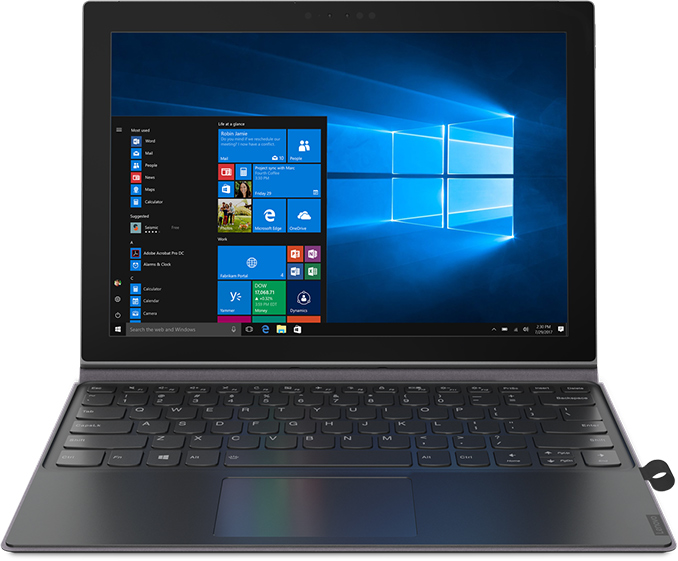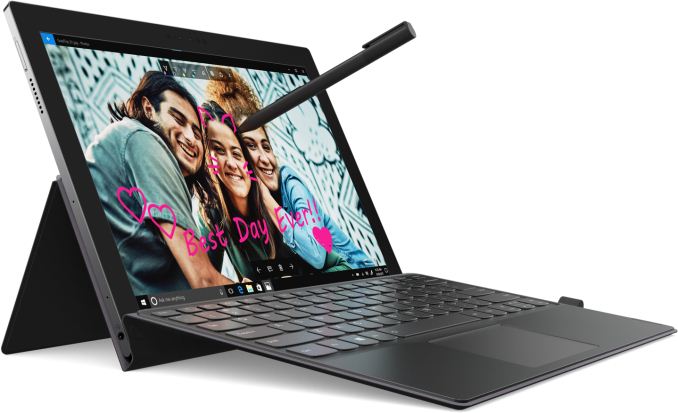Lenovo’s Miix 630 Snapdragon 835-Based 2-in-1 Now Available
by Anton Shilov on July 10, 2018 3:00 PM EST- Posted in
- Laptops
- Systems
- Lenovo
- Arm
- Tablets
- Windows 10
- Snapdragon 835
- SD835
- Miix 630

Lenovo has started to sell its Miix 630 always-connected PC based on Qualcomm’s Snapdragon 835 SoC and Microsoft’s Windows 10 S. The system weighs around 1.4 kilograms yet promises up to 20 hours of battery life with a perminent connection to the internet when in cell-tower coverage.
Lenovo’s Miix 630 is a 2-in-1 detachable notebook with a 12.3-inch FHD+ display and a 15.6 mm z-height when equipped with a keyboard. The system is outfitted with Qualcomm’s Snapdragon 835 SoC, 4 GB of LPDDR4-1866 memory, 128 GB of UFS 2.1 storage, 2x2 802.11ac Wi-Fi, Bluetooth 4.1, and an integrated Gigabit LTE modem. Since the Miix 630 uses a mobile SoC, it is always connected to a 4G/LTE network and offers a very long battery life because it is equipped with a laptop-class 48 Wh battery: Lenovo rates the system for 20 hours of video playback at 150 nits screen brightness.
The 2-in-1 comes with Microsoft’s Windows 10 S, but there is an option to upgrade to Windows 10 Pro for free within the first 180-days after initial registration. Since the Snapdragon 835 is designed to be more space and efficient than the competition, the Miix 630 is rated to work significantly longer than the vast majority of ultra-thin notebooks.
As reported previously, the platform supports applications through the Windows Store that are natively compiled for the S835, as well as non-native 32-bit apps through machine translation. Qualcomm is still in the middle of developing its 64-bit SDK, as well as looking into translation of non-native 64-bit apps. We covered the topic when Qualcomm announced the Snapdragon 850. For some power users, this may be a limitation at this time, however most regular program suites for business use are ready and operational for full performance.
Lenovo charges $899.99 for the Miix 630 product, which is the price that Microsoft charges for its entry-level Surface Pro 4 2-in-1 that is powered by Intel’s Core m3-6Y30 SoC.
Lenovo’s Miix 630 is now available both directly from Lenovo as well as from retailers like Amazon.
| The Lenovo Miix 630 | ||
| Specifications | ||
| Display | 12.3" 1920×1280 187 PPI 400 nits |
|
| CPU | Qualcomm Snapdragon 835 4 x Kryo 280 Performance (2.45 GHz) 4 x Kryo Efficiency (1.9 GHz) |
|
| Graphics | Adreno 540 GPU at 710 MHz | |
| RAM | 4 GB | |
| Storage | 128 GB + microSD | |
| Wi-Fi | 2×2 802.11ac Wi-Fi | |
| Bluetooth | Bluetooth 4.1 | |
| WWAN | Qualcomm X16 Gigabit LTE | |
| USB | 3.0 | 1 × Type-C |
| Cameras | Front | 5 MP with IR and Windows Hello |
| Rear | 13 MP | |
| Other I/O | Microphone, stereo speakers, audio jack, trackpad, card reader, etc. | |
| Battery | 48 Wh | |
| Battery Life | 20 hours | |
| Dimensions | Width | 293 mm | 11.5" |
| Height | 210 mm | 8.2" | |
| Thickness | 15.6 mm | 0.6" w/ keyboard | |
| Weight | 1.39 kilograms | 2.93 lbs | |
Related Reading
- Qualcomm Announces Snapdragon 850: A Second Generation For Windows
- HP’s Snapdragon 835-Based Envy X2 2-in-1 Available for Pre-Order, Starts at $999
- Lenovo Unveils Miix 630 2-in-1: Windows 10 S, Snapdragon 835, Gigabit LTE, 20 Hrs
- ASUS Announces the NovaGo (TP370): A Snapdragon 835 based Windows 10 PC
- Microsoft Launches Windows 10 On ARM: Always Connected PCs
- Microsoft and Qualcomm Collaborate to Bring Windows 10 & x86 Emulation to Snapdragon Processors
Source: Lenovo (via Liliputing)












34 Comments
View All Comments
Lolimaster - Thursday, July 12, 2018 - link
It will probably hurt the Surface brand from such a lackluster performance.Even a 4core AMD Jaguar shrinked to 12nm would absolutely murder this thing.
HStewart - Tuesday, July 10, 2018 - link
First a all a Surface Pro 4 2in1 with m3-6Y30 would blow away this thing - especially for desktop apps. I feel sorry for the suckers buying this thing and desiring a real PC. I have an Lenovo Mixx 2 with Atom process which would like beat this thing with desktop applications.For this price even cheaper - if you want a device like this go for Samsung Galaxy Tab S3 or S4 when it comes out. You be better off - If this Lenovo was price under $300 or $400 it would be worth playing around - otherwise you are wasting money.
Jhlot - Tuesday, July 10, 2018 - link
Where is the laptop dock that seamlessly turns my phone into a well functioning laptop with a quality screen and keyboard? I also want a desktop dock so I can use my phone for work at a desk, for work on the gone and as phone. Why isn't there a Windows phone that turns into a surface device Microsoft? Google why isn't there a pixelbook sans guts that my pixel phone can dock with and become a laptop? This can be done, Motorola did it years ago with the Atrix, it could be done much better now and work well.Arbie - Tuesday, July 10, 2018 - link
Aren't the Windows Phone 10 "Continuum" devices exactly what you're requesting? Just as one example, the Alcatel Idol 4S, and the MS Continuum Dock.Jhlot - Wednesday, July 11, 2018 - link
Reviews like https://www.theverge.com/2017/2/24/14696730/hp-eli... show it needs a lot more effort put into it, because the phones are poor and the Windows experience is poor still and it is way over priced. $599 for the HP dock with no guts inside...., nearly the price a entry surface pro.TheinsanegamerN - Wednesday, July 11, 2018 - link
Not to mention windows 10 mobile is Dead in the water. MS doesnt care about it anymore, hardware support has dried up, ece.philehidiot - Tuesday, July 10, 2018 - link
Now what we need to see is the performance of x86 applications on the ARM stuff.The issue is that you can do most basic stuff on a tablet with an ARM SoC and it works just dandy. Anything that requires more poke from the CPU is not going to be used on something like this.
Therefore, you might as well buy an Android tablet for most use cases as anything that has low oomph requirements would work on the many existing x86 CPU tablety things out there and anything that you want to do more is served by the Android market. I just struggle to see a large market for this stuff although I must say I am attracted to it. My attraction is more the "what can I do to fiddle with this" rather than any specific use case though and that isn't exactly a mainstream approach to buying hardware.
I shall be very interested to see how they've emulated on this and how well it performs. Generally these things in my experience (which does date back a long way and isn't recent) throw raw horsepower at the problem with poorly coded emulation software. I have no real understanding of the differences between x86 and ARM aside from the instruction set is limited and therefore from my understanding what would be one instruction on an x86 chip could possibly take 2 or 3 cycles to complete on ARM. If I'm wrong please do correct me as I'm not a compsci, I'm an idiot.
I apologise to all for the ramble. I've been drinking with my opiates and benzos. It makes them work better. My back merely aches now.
Alistair - Tuesday, July 10, 2018 - link
People don't like buying already outdated CPU's. Seems like this is going to be a problem. Release a snapdragon 845 based laptop when the lg g7 or oneplus launches, and people might actually be interested.Lolimaster - Thursday, July 12, 2018 - link
The emulated performance is just bad, horrible even at native store apps it barely competes to the lowest end of atoms just before airmont core. And it's wiped out by that that obsolete atom in native x86...TheinsanegamerN - Wednesday, July 11, 2018 - link
WAY too expensive for such a limited product. You can buy core i5 machines for $600-700 that will outperform this any day of the week.I thought ARM was supposed to save us from paying ridiculous amounts for hardware. If ARM costs as much as x86, why wouldnt you buy x86?